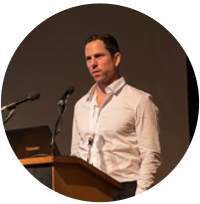Plenary Lectures
|
Dan M. Frangopol The Fazlur Rahman Khan Endowed Chair of Structural Engineering and Architecture Professor of Civil Engineering, Department of Civil and Environmental Engineering, ATLSS Center, Lehigh University, Bethlehem, PA 18015-4729, USA Extending the Service Life of Civil and Marine Structures: Role of Monitoring, Probabilistic Life-cycle Management and Risk-based Decision Making |
Biography
Dan M. Frangopol is the inaugural holder of the Fazlur R. Khan Endowed Chair of Structural Engineering and Architecture at Lehigh University. Before joining Lehigh University in 2006, he was Professor of Civil Engineering at the University of Colorado at Boulder, where he is now Professor Emeritus. His main research interests are in the development and application of probabilistic concepts and methods to civil and marine engineering. He is recognized as a leader in the field of life-cycle engineering of civil and marine structures under various types of hazards. Dr. Frangopol is the Founding President of the International Association for Bridge Maintenance and Safety (IABMAS) and International Association for Life-Cycle Civil Engineering (IALCCE). He has authored/co-authored 3 books, more than 50 book chapters, and over 420 articles in archival journals including 11 prize winning papers. He is the Founding Editor of Structure and Infrastructure Engineering and of the Book Series Structures and Infrastructures. Dr. Frangopol is the recipient of several medals, awards, and prizes, from ASCE, IABSE, IASSAR, SAE and other professional organizations. He has served as a consultant or advisor to companies in North America, Asia, and Europe. He holds 4 honorary doctorates and 14 honorary professorships from major universities. He is an Elected Member of the US National Academy of Construction, a Foreign Member of the Academy of Europe (London), a Foreign Associate of the Engineering Academy of Japan, a Foreign Member of the Royal Academy of Belgium, an Honorary Member of the Romanian Academy, an Honorary Member of the Romanian Academy of Technical Sciences, and a Distinguished Member of ASCE.
Abstract
Structural deterioration can pose tremendous risk to the functionality, serviceability, and safety of civil and marine structures, considerably limiting their service life. To extend the life-cycle of existing structures under deterioration, rational life-cycle management should be conducted accounting for various uncertainties arising from loads, resistance, and modeling. Compared to conventional inspection methods that are sometimes disruptive and costly, structural health monitoring provides a novel and cost-efficient approach to reducing uncertainties and ultimately facilitating the decision-making process for realizing structural longevity. In this plenary lecture, recent accomplishments in the integration of monitoring, probabilistic life-cycle management and risk-based decision making for extending the service-life of civil and marine structures are presented.
|
C. F. Jeff Wu Georgia Institute of Technology https://en.wikipedia.org/wiki/C._F._Jeff_Wu From Parameter Design to Data Science |
Biography
F. Jeff Wu is Professor and Coca Cola Chair in Engineering Statistics at the School of Industrial and Systems Engineering, Georgia Institute of Technology. He was elected a Member of the National Academy of Engineering (2004), and a Member (Academician) of Academia Sinica (2000). A Fellow of American Society for Quality, of Institute of Mathematical Statistics, of INFORMS, and of American Statistical Association. He received the COPSS Presidents’ Award in 1987, COPSS Fisher Lecture Award in 2011, Deming Lecture in 2012. He has won other awards, including the Shewhart Medal (2008), the Pan Wenyuan Technology Award (2008), Class of 1934 Distinguished Professor Award and Sigma Xi Monie A. Ferst Award both at Georgia Institute of Technology in 2020. He was the 1998 Mahalanobis Memorial Lecturer at the Indian Statistical Institutes, received the inaugural Akaike Memorial Lecture Award in 2016 sponsored by the Japan Statistical Society and the Institute of Statistical Mathematics, Tokyo, the 2017 Box Medal from ENBIS, and an honorary doctor degree at the University of Waterloo.
He has published more than 185 research articles. He has supervised 50 Ph.D.'s, out of which more than half are teaching in major research departments in statistics/engineering/business in US/Canada/Asia/Europe. Among them, there are 22 Fellows of ASA, IMS, ASQ, IAQ, and IIE. He co-authors with Mike Hamada the book "Experiments: Planning, Analysis, and Optimization" (Wiley, 3rd ed. 2021) and with R. Mukerjee the book “A Modern Theory of Factorial Designs” (Springer, 2006).
Abstract
In this talk I will first trace the history of my role in the coining of the term “data science”. For many years since the early 1980s, I had grown dissatisfied with using the term “statistics” to describe my profession because it is usually connected with descriptive statistics, while what statisticians do can be summarized as a trilogy of data collection, data modeling, and problem solving. Thus I proposed the terms data science and data scientist in a public lecture at the U. of Michigan in 1997. With the explosion of huge data collected through the internet, data science has grown to become a very popular, fashionable and impactful profession. I will describe how it is so different from the traditional meaning and work of statistics. A major new component is the role played by computer scientists and the new emphases on algorithms, coding and huge data they bring in. I will end with some examples about the applications to uncertainty quantification and variation reduction.
|
Patrice Aknin Directeur Scientifique Institut de Recherche Technologique SystemX https://www.researchgate.net/profile/Patrice_Aknin Artificial Intelligence, Safety and Reliability : an old story or a new age? |
Biography
Patrice Aknin is a data science researcher who hold the position of Scientific Director at IRT SystemX since 2016. SystemX is an RTO (Research Technological Organisation) located in Saclay, near Paris, which is positioned as an accelerator of the digital transformation of industry, services and territories. Previously, he was Scientific Director at SNCF, the French national railway company. Between 1988 and 2013, he held various positions as a Researcher and then Research Director at Ifsttar (French Institute of science and technology for Transport, Developement and Networks), which recently became the University Gustave Eiffel. He is professor at Ecole des Ponts Paristech and also at Télécom Paris. He is a member of several scientific councils of prestigious institutions such as ENS Paris-Saclay, Télécom SudParis and ENSTA Paris. He has directed the PhD work of about twenty students. He is the author or co-author of nearly 150 publications in the fields of diagnosis, data science, maintenance, mainly on applications in the field of transport.
Abstract
The new proposals of artificial intelligence, and especially data science, are now flooding the scientific field, the industrial field, and, more generally, society. These proposals are not limited to the progress in machine learning itself, especially in deep learning. Indeed, many scientific areas are impacted and are facing significant evolutions: image recognition, scientific computation aggregating physical models and data-based models, data augmentation, natural language processing, optimization and reinforcement learning, new digital twins, cyber-detection by machine learning, supervision of large industrial systems, bidirectional digital assistants (learning from and to the expert), hybridization between symbolic AI and connectionist AI... The fields of safety, maintenance, and reliability are not exempt from this surge and these promises. But is this safety-IA hybridization new? One could say that until now, data science has come to the rescue of safety to help describe aging processes, stochasticity of states and their transitions, .... In its unsupervised versions, it can also be of great help in detecting cases of failure not yet observed in real life. Today, with the explosion in the number of AI algorithms integrated into industrial and service systems, the question arises about their validation and confidence placed in them. Safety sees before it a new field of application of exponential size where the usual tools are helpless in the face of the combinatorial nature of states and operational domains with an increasingly wide spectrum. The talk proposes response elements to these dual-entry questions. It will illustrate them through current applications such as autonomous vehicle validation, fault diagnosis of large critical systems, and rail maintenance.
|
Jean-Christophe LE COZE Safety researcher Institut national de l'environnement industriel et des risques (Ineris) https://ineris.academia.edu/jeanchristophelecoze Cognitive, practical, organisational and regulatory safety challenges of a new era |
Biography
Jean-Christophe Le Coze is a safety researcher (PhD, Mines ParisTech, HDR) at INERIS, the French national institute for environmental safety. His activities combine ethnographic studies and action research in various safety-critical systems. He is the editor of the book “Safety Science Research. Evolution, Challenges and New Directions” (2019) and author of “Post Normal Accident. Revisiting Perrow’s classic” (2020).
Abstract
Safety-critical systems such as offshore platforms, hospitals, aircrafts, nuclear power plants, refineries, bridges, dams, mines … rely on a myriad of artefacts, actors and institutions to operate safely. It is an admirable political, technological, social and economic endeavour re-enacted everyday all over the world. But sometimes, when a bridge collapses, a building burns, an offshore platform explodes, a nuclear reactor melts down, a train derails, a ship sinks or a plane crashes, we are reminded how precarious such successes are and we are also reminded of the diversity of practices across countries, sectors and companies. The Boeing 737 Max crashes in 2018 and 2019, the Grenfell tower fire in London in 2017 or the collapse of Vale’s dam in Brazil in 2019 are recent reminders of such events. The analysis of these events reveal a number of features which characterise the current operating landscape of safety-critical systems which includes globalisation, digitalisation, externalisation or financialisation. What many safety-critical systems share these days are their properties of ‘networks of networks’ which requires for safety research to explore their cognitive, practical, organisational and regulatory features together (to which one needs to add their ecological side). This is a complex and ambitious endeavor. The talk will provide insights from a collective book ‘Safety Science Research: Evolution, Challenges and New Directions’ (CRC Press, 2019) which addresses this problem.
|
Catherine Mouneyrac Professor in Ecotoxicology, Vice-Rector for research and valorization (Université Catholique de l’Ouest -Angers, France) Safer by design concept |
Biography
Catherine Mouneyrac, Professor in Ecotoxicology, Vice-Rector for research and valorization (Université Catholique de l’Ouest -Angers, France) is titular of a PhD (University of Lyon I, France) in animal physiology, then a DSc in aquatic ecotoxicology (University of Nantes, France). Her general field research concerns the response of organisms to natural and chemical stress, namely nanomaterials. At the interface of fundamental and applied research, she aims to fulfill the gap between ecological and (eco)toxicological approaches, the final objective being to help environmental diagnosis. She collaborates with researchers all around the world and has participated to the conception and realization of numerous national and international scientific projects (NanoSalt; NanoReTox; NANoREG…). She is part of the Expert committee on the assessment of the risks related to physical agents, new technologies and development areas at the French Agency for Food, Environmental and Occupational Health & Safety (Anses). She is scientific officer at ANR and has been selected as a decision-makers a to follow the national study course of the Institut des Hautes Etudes pour la Science et la Technologie (http://www.ihest.fr).
Abstract
Because the physicochemical properties of nanoparticles are distinct from their bulk counterparts, the fast growth of nanotechnologies has brought new industrial and business opportunities. The field of nanotechnology has shown a huge expansion during the last decade and the key challenge is how to take into account potential risks to human and environmental health posed by long-term exposure to and accumulation of nanoparticles? However, manufactured nanomaterial production is out pacing the ability to investigate environmental hazard using current regulatory paradigms, causing a backlog of materials requiring testing. Based on results from toxicological and ecotoxicological studies, researchers now have a better grasp on the relationships between the nanomaterials' physicochemical characteristics and their hazard profiles. Nowadays, it is expected that an integration of design synthesis and safety assessment will foster nanomaterials safer‐by‐design by considering both applications and implications. Multiple case studies will be presented on the safer by design concept.







